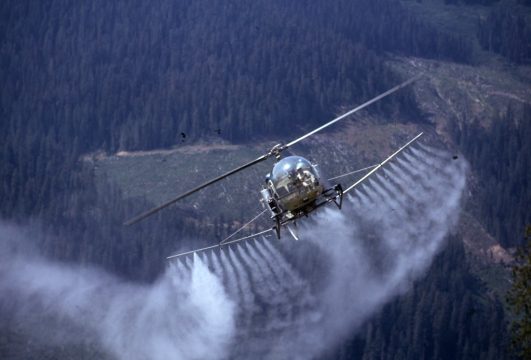29
Jun
Maine Aerial Forestry Spray Ban of Glyphosate and Other Herbicides Vetoed by Governor, Override Effort Begins

(Beyond Pesticides, June 29, 2021) Maine Governor Janet Mills (D) last week vetoed legislation prohibiting the aerial use of glyphosate and other dangerous herbicides in forestry practices. LD125, An Act To Prohibit the Aerial Spraying of Glyphosate and Other Synthetic Herbicides for the Purpose of Silviculture, was supported by a wide range of health and conservation groups, and aimed to bring the state in line with best practices for public health and the environment. With Maine recently passing one of the strongest consumer bans on pollinator-toxic neonicotinoids, advocates are dismayed by the setback from the Governor’s office.
In a statement to Maine Public Radio, Senate President Troy Jackson said that Governor Mills should stop referring to herself as an environmentalist. “The science across the country, across the world, says that this stuff kills people, kills wildlife,” Mr. Jackson says. “And all that it is, is a giveaway to the large landowners so they can maximize their profits off the lives of the people in Maine and the wildlife in Maine.”
Senator Jackson’s words are stern yet factual. Glyphosate has been identified by the World Health Organization as a probable human carcinogen. Monsanto, now owned by Bayer, has been the subject of high profile lawsuits that have been so successful, the company has set aside $10 billion to resolve existing claims. In addition to cancer, the chemical has been linked to changes in DNA function, adverse birth outcomes, and antibiotic resistance.
Forestry applications also put the environment at risk. Runoff pollutes groundwater, which can run into local rivers, lakes, and streams. Erosion caused by glyphosate use can release legacy pesticides back into the environment, quickly multiplying problems from chemical mixtures. Glyphosate has been found to harm keystone wildlife species that comprise the bottom of the food chain. Likewise, certain glyphosate formulations have been found to harm pollinators directly, but the entire range of herbicides used in forestry will eliminate the floral diversity on which pollinators rely. Just last week a Canadian study found that the use of glyphosate in forestry practices prompted morphological changes that may make them less attractive to pollinators.
While glyphosate is likely the most frequently used pesticide in forestry applications, a range of toxic synthetic pesticides could be used in its place. Like all pesticides registered by EPA’s criticized regulatory process, these chemicals are not reviewed in formulation—and ‘tank mixes,’ with multiple pesticides mixed together—are a popular application technique in forestry operations. Under current EPA regulations, pesticides are not restricted for their ability to cause endocrine (hormone disruption), numerous health endpoints are often left unaddressed, children and other sensitive populations are often not provided protective safety factors, and the manufacturer of the chemical to be registered conducts all the health and safety studies submitted to the agency.
In a statement released after the veto, Governor Mills wrote, “Banning aerial application would force landowners to conduct ground application, which is manually intensive, has a potential greater site disturbance…and may require multiple applications with higher and more dangerous concentration levels to achieve the same level of effectiveness.”
Reports indicate that the Governor came under pressure from large landowners and the forestry industry, powerful forces at the state level in the Pine Tree State. But the reasoning for the veto rings hollow when alternative means of managing valuable timber crops can be successful without the use of toxic herbicides. In the nearby state of Vermont, there has been a ban on aerial pesticide use in forestry since the late 1990s.
Governor Mills indicates that she will work with state agencies to impose further restrictions on the aerial use of pesticides. Senate President Jackson will fight to override the Governor’s veto, although the chance of success is viewed as slim. If unsuccessful, Senator Jackson indicates that a citizen referendum may be on the horizon.
Maine residents are encouraged to find their Maine state legislators and urge them to override the Governor’s veto. For more information on the dangers pesticides pose to waterways, wildlife and their habitat, see Beyond Pesticides program pages on biodiversity and water contamination.
All unattributed positions and opinions in this piece are those of Beyond Pesticides
Source: Maine Public Radio










